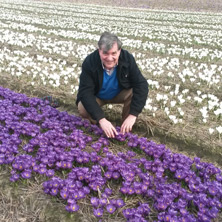Crocus
Crocus Bulbs

About Crocus Flowers
Crocus is a genus of flowering plants from the iris family comprising 90 species of perennials growing from corms. Crocuses are amongst the first flowers to bloom in spring, their goblet-shaped heads peeking through the snow spread delightful color around the white, snowy landscape! They're ideal for containers, borders and rock gardens, great for naturalizing, as also for attracting bees and other beneficial pollinators. Crocus bulbs not only provide winter garden color, but they naturalize, meaning that they spread and come back year after year.Do Crocuses come back every year?
Crocus bulbs not only provide winter garden color, but they naturalize, meaning that they multiply and come back year after year with minimal care.How long do crocus flowers last?
Crocus bulbs bloom in the spring or fall depending on the species after 4 to 10 weeks. The flowers stay in bloom for about 2 to 5 weeks.How do I plant crocus bulbs?
Crocuses are most impressive when planted en mass. Pick out a large sunny area in the garden, lawn, or a wild area (rocky spots are great). Plant large drifts using groupings of 20-30 bulbs spaced about 3-4" apart. Crocus are ideal for this kind of naturalizing. Many varieties will thrive and bloom for upwards of 20 years! In the lawn, crocus have perfect timing. They will bloom well before grass starts to grow and by the time it reaches mowing height, the crocus are finished for the season. Established crocus clumps bloom earlier than first-year plantings, so avoid planning your garden colours around first-year bloom times.Crocus are easy to grow! Plant your crocus in the Fall in large drifts anywhere you have sun to partial shade. Place bulbs 3-6" deep and space them about 3-4" apart. Crocus require almost no care and are hardy in zones 4-8. If your crocus seem to perform poorly, the most likely reason is over-watering in the summer. Crocus prefer their soil damper in the spring and fall, but dry and warm during the summer. Never plant crocus near summer annuals or other water-hungry summer blooms. As you give the annuals the water they need, you will be "drowning" the crocus and shortening their life. Excellent companion plants for crocus include flowering quince, forsythia, Asian jasmine, and witch hazel.
Crocus Flower Basics:
Crocus is a genus of flowering plants from the iris family comprising 90 species of perennials growing from corms. Crocuses are amongst the first flowers to bloom in spring, their goblet-shaped heads peeking through the snow spread delightful color around the white, snowy landscape! They're ideal for containers, borders and rock gardens, great for naturalizing, as also for attracting bees and other beneficial pollinators. Crocus bulbs not only provide winter garden color, but they naturalize, meaning that they spread and come back year after year.Where To Plant:
Crocus grow best in partial to full sun, and prefer well-drained soil. Crocus are particularly fond of open-area locations, where they'll have room to multiply and naturalize. Many gardeners create a meadow our of crocus, mixing them with grasses or other low-growing flowers. Consider planting crocus in masses along the edge of flower beds, or in front of taller spring-flowering bulbs and perennials. Or, try planting crocus in lawns to create a beautiful springtime "carpet" before the mowing season.Height/Spread:
While all crocuses are low-growing, they do vary in size by variety. Early snow crocuses may only open to an inch or two in width, and under three inches in height. Giant crocuses may reach widths of three to four inches and can stand half a foot tall. Most crocuses can be planted just a few inches apart from one another. These flowers are perfect for mass plantings.Exposure:
One of the best aspects of crocus plants: their hardy nature. Crocuses, along with snowdrops, are typically the very first flowers to appear in early spring. Their leaves and shoots can withstand late-winter chill, but you can send them off to the right start by applying mulch in the fall. Once the plants have budded, it's best to protect crocus flowers from severe weather. Use buckets, jugs, or hoop structures to cover plants during February and March's cold snaps, especially if you're growing early bloomers.When do crocus bloom?
We tend to think of crocus are early risers, peeking through snow in late February. However, different varieties of crocus flowers bloom at different times. Snow crocuses are the very first to appear, often the first sign of color after a long winter. In most temperate American climates, snow crocuses sprout in February or early March. Dutch crocus, including giant Dutch crocus, bloom in early spring. And, some varieties of crocus actually operate on the other side of the winter spectrum, blooming in fall. Fall-blooming crocuses may open between October and December. Crocuses are truly the perfect flower to fill in the garden or lighten up the lawn during those bare times!Color and characteristics:
Crocus are low-growing plants, opening in hues of pink, purple, mauve, white, and yellow. Most crocus feature a bell-shaped flower with six petals, and long, strap-shaped leaves that look like early grasses. Crocus can be propagated by division or pollination, but most crocus divide easily underground, multiplying by creating new corms. Crocuses look gorgeous in mixed varieties, or in monochromatic groupings.Types Of Crocus Flowers:
Dozens of types of crocus exist, so we've selected the ones that perform the very best in American gardens. Among our favorites:Crocus Bulbs Tips & Growing Instructions

Crocus refers to a genus of several dozen species of small clump-forming perennials that have their origins in many different Zone 3 regions from southern Europe to China. They are most noted for being some of the very earliest spring flowers. Crocus have since been cultivated into a wide variety of hybrids, most developed in Holland.
Crocus are most impressive when planted en mass. Pick out a large sunny area in the garden, lawn, or a wild area (rocky spots are great). Plant large drifts using groupings of 20-30 bulbs spaced about 3-4" apart. Crocus are ideal for this kind of naturalizing. Many varieties will thrive and bloom for upwards of 20 years! In the lawn, crocus have perfect timing. They will bloom well before grass starts to grow and by the time it reaches mowing height, the crocus are finished for the season. Established crocus clumps bloom earlier than first-year plantings, so avoid planning your garden colours around first-year bloom times.
 Crocus are easy to grow! Plant your crocus in the Fall in large drifts anywhere you have sun to partial shade. Place bulbs 3-6" deep and space them about 3-4" apart. Crocus require almost no care and are hardy in zones 4-8. If your crocus seem to perform poorly, the most likely reason is over-watering in the summer. Crocus prefer their soil damper in the spring and fall, but dry and warm during the summer. Never plant crocus near summer annuals or other water-hungry summer blooms. As you give the annuals the water they need, you will be "drowning" the crocus and shortening their life. Excellent companion plants for crocus include flowering quince, forsythia, Asian jasmine, and witch hazel.
Crocus are easy to grow! Plant your crocus in the Fall in large drifts anywhere you have sun to partial shade. Place bulbs 3-6" deep and space them about 3-4" apart. Crocus require almost no care and are hardy in zones 4-8. If your crocus seem to perform poorly, the most likely reason is over-watering in the summer. Crocus prefer their soil damper in the spring and fall, but dry and warm during the summer. Never plant crocus near summer annuals or other water-hungry summer blooms. As you give the annuals the water they need, you will be "drowning" the crocus and shortening their life. Excellent companion plants for crocus include flowering quince, forsythia, Asian jasmine, and witch hazel.
Crocus are most impressive when planted en mass. Pick out a large sunny area in the garden, lawn, or a wild area (rocky spots are great). Plant large drifts using groupings of 20-30 bulbs spaced about 3-4" apart. Crocus are ideal for this kind of naturalizing. Many varieties will thrive and bloom for upwards of 20 years! In the lawn, crocus have perfect timing. They will bloom well before grass starts to grow and by the time it reaches mowing height, the crocus are finished for the season. Established crocus clumps bloom earlier than first-year plantings, so avoid planning your garden colours around first-year bloom times.
 Crocus are easy to grow! Plant your crocus in the Fall in large drifts anywhere you have sun to partial shade. Place bulbs 3-6" deep and space them about 3-4" apart. Crocus require almost no care and are hardy in zones 4-8. If your crocus seem to perform poorly, the most likely reason is over-watering in the summer. Crocus prefer their soil damper in the spring and fall, but dry and warm during the summer. Never plant crocus near summer annuals or other water-hungry summer blooms. As you give the annuals the water they need, you will be "drowning" the crocus and shortening their life. Excellent companion plants for crocus include flowering quince, forsythia, Asian jasmine, and witch hazel.
Crocus are easy to grow! Plant your crocus in the Fall in large drifts anywhere you have sun to partial shade. Place bulbs 3-6" deep and space them about 3-4" apart. Crocus require almost no care and are hardy in zones 4-8. If your crocus seem to perform poorly, the most likely reason is over-watering in the summer. Crocus prefer their soil damper in the spring and fall, but dry and warm during the summer. Never plant crocus near summer annuals or other water-hungry summer blooms. As you give the annuals the water they need, you will be "drowning" the crocus and shortening their life. Excellent companion plants for crocus include flowering quince, forsythia, Asian jasmine, and witch hazel.









